

|
Back to |
| The Front Page |
| News & Features |

|
The preview opening - the National Croquet Center nearing completion |
|||||
|
text and photographs by Bob Alman Posted October 30, 2001
|
|
||||
This story is about the National Croquet Center, but because it is beautifully peopled by players in the biennial Carter Challenge between the 6-person teams of Ireland and the United States and the American Rules National Championships of 2001, you have to first know what happened in those events.
“I had no idea it was anything like this.” I heard this comment countless times during the USCA National Championships at the National Croquet Center in mid-October. It was the largest of two events held at the Center in West Palm Beach by special permit, just two months shy of the projected completion date in December. Many finishing touches yet remain to be done but in these pictures the real dimensions of this unlikely project are already evident. I briefly considered doctoring the pictures to give a truer accounting of what this place will look like in two months. I could easily have painted the gray concrete walls of the clubhouse their “true” white stucco and the black roof its green metal finish. In my computer console, I could quickly grow the hedges higher that will screen the lawns from the houses across Summit Boulevard and hide from view the 92-space parking lot in front of the clubhouse. But it isn't necessary; the imagination so easily fills in these gaps. Look at these October pictures, and imagine croquet's national home.

|
Jeff Soo was a big player in both events. Here is his account of the Carter Challenge, the first international competition held at the Center, as posted on the Events Board of Croquet World Online.
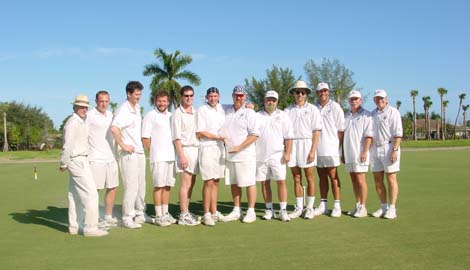
|
| The Irish team (left) and the American team (right) share for a moment the crystal Carter Cup held by team captains Ronan McInerney and Jerry Stark. |
"Ireland won their third consecutive victory in the biennial Carter Challenge. The final score was Ireland 11, USA 10. The twelve singles matches were split 6-6, while Ireland had a 5-4 edge in doubles. Ireland were leading 9-6 going into the final day, needing only two wins in the final six singles matches. USA #1 Jerry Stark was the first to complete a match, beating Ireland #1 Mark McInerney with a pair of triples. Ireland #3 Ronan McInerney then finished his match against USA #3 Kenster Rosenberry, also with two triples. Ireland #2 Simon Williams clinched the team victory by beating USA #2 Jeff Soo in a three-triples match. The Americans won the remaining matches. USA #5 Doug Grimsley won 2-0 against Ireland #5 Andy Johnston. USA #6 Dan Mahoney came back from game down to beat Ireland #6 Evan Newell, Mahoney finishing in style with a triple in the third game. USA #4 Bob Cherry also came back from game down against Ireland #4 Patsy Fitzgerald."
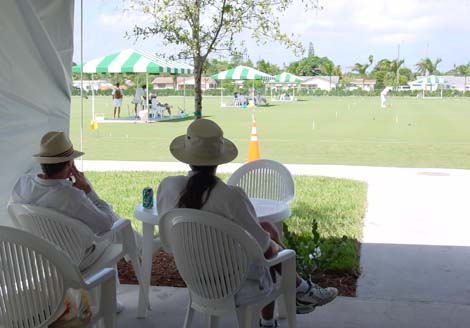
|
| Evan Newell of Ireland and Jeff Soo of North Carolina take a break from their Carter Challenge matches in the shade of the Festival Tent. |
Each day saw the American team - who so seldom get to play together as a team - gaining in strength against the Irish, who all play at the country's dominant club in Carrickmines, a suburb of Dublin. Such was the abundance of lawn space - only six of the Center's 12 lawns were used - that the competition, for the first time in its history, was played entirely in only four days, leaving the fun-loving Irish plenty of time to explore the sights of South Florida by day and the nightspots after dark.
The Carter Challenge ended on Saturday, and by Sunday noon the parking lot in front of the clubhouse was nearly full of players arriving for the first National Championships to be held at the Center. The lawns themselves could easily support a tournament of 90 or more, but this one drew only 65 players - a number that everyone was satisfied with, given the uncertainty of the times and the fact that the special permit to hold the event at a construction site had not come through until September.
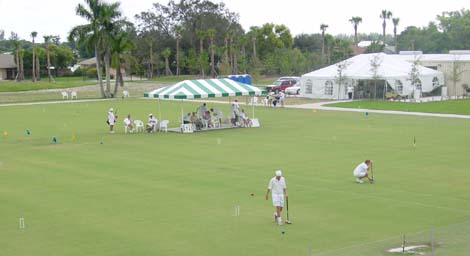
|
| Gazebo #1 viewed from a window in the Croquet Museum on the second floor of the clubhouse. |
The daily postings on the Events Board of this magazine diarize what was actually six tournaments - both singles and doubles in three flights. The postings report that the lawns were fantastic, the perfection of the weather was divinely ordained, and everybody had a great time. They did not report the complaints - of which I heard only two, about the food and the parking: "The lunches were too rich." And, "I had to park in the church lot next door." (Although the clubhouse parking lot holds only 92 cars, the contingency parking plan can provide an additional 100 spaces on adjacent properties.)
Surely there must have been complaints about "unfair ladders" - aren't there always, in every tournament? But to tournament director Fred Jones' credit, I heard no such complaints. From over here - in my office 30 yards from the courts - the seven days of the championship looked uniformly smooth and easy.
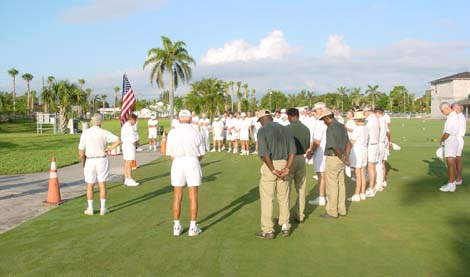
|
| The 2001 USCA National Championships begin in the early morning with a moment of silence. |
The big story of the tournament was the remarkable duo from North Carolina who won everything, in both singles and doubles - Jeff Soo and Paul Scott. The consistent high standard of their play almost convinces one that the seat of croquet player power has shifted, after almost two decades, from the West Coast back to the East Coast where USCA croquet started. Almost, but not quite: I have to be careful about my hyperbole, because this North Carolina pair have accused me - in a friendly way - of making too much of their romp through singles and doubles undefeated. (Soo scored 26 points in ten successive singles games, holding the opponent to two points in four of them.)
Not that I was alone in this. It was croquet pro Bob Kroeger who came forward on the last day of the tournament with a proposal to create "Advanced Rules" that would prevent the winner of the coin toss getting the innings and putting away the game 26-2 before the opponent has a chance to take croquet. Soo and Scott suggested modestly that this might not yet be necessary and then provided evidence that the 26-2 results were not always as simple as they seemed. Scott's victory over Soo (the only game Soo lost in the entire week) took, in fact, 26 turns; both players had a chance.
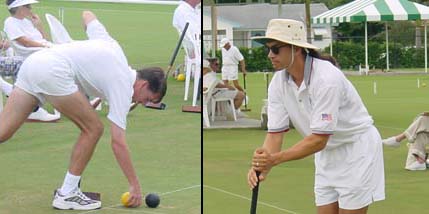
|
| Paul Scott (left) the new national champion takes croquet from Corner One. 2000 national champion Jeff Soo (right) won every singles game 26-2 - until his loss to partner Paul Scott in the final by the same score. |
But the conversation could not be stopped. The consensus remains that on lawns this flat and evenly textured, with players this good, some "Advanced Rules" remedy should be considered to prevent the "killer leave." The most popular suggestion was to allow the opponent at the end of the leave to play either ball and thus begin a new rotation. There are, of course, problems with this, so many alternatives will be proposed and the conversation will probably wind up on the agenda of the Rules Committee.
Should we be distressed by this? Of course not. There are more difficult challenges in the sport than having players that are too skilled and lawns that are too perfect.

|
In business terms, it remains a high-risk venture. But now, everyone who loves the sport can see the possibility in front of them that this Center represents: 12 lawns, a Youth Development Program for high schools and colleges that is already under way; year-round free and low-cost lawn access for anyone who wants to learn croquet, which has already sparked the building of the first public court in Florida in nearby Broward County; and a resort-class membership that has already inspired some local people to join the National Croquet Club - and they don't know how to play croquet yet!
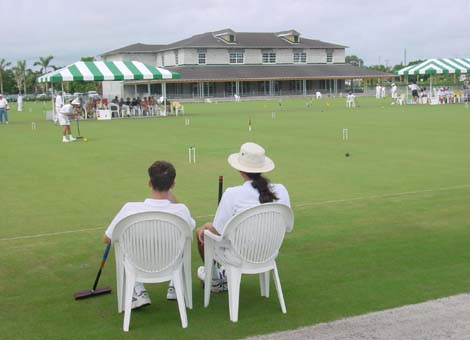
|
| Scott and Soo watch the doubles final they were losing against Osborn and Brown until the final rotation. |
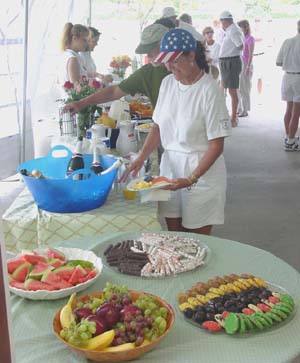
|
If the National Croquet Center achieves nothing else, it will show the true nature of this sport to millions of people who still don't have a clue - including the dedicated backyard player with toy equipment on a bumpy lawn who has so often mused, "This could really be a great game, if only..." "If only" has happened. A prominent Palm Beach croquet booster called this place "croquet's Camelot." That's a high compliment, coming from Palm Beacher. Last week I got a call from a Connecticut player who asked, "Can I apply my Affiliate Membership ($250) to a 2001 Club Charter Membership ($2001)?" The answer, of course, is YES.
If our players spent half what the average golfer spends on the sport, all the bills would already have been paid for this Center. Everyone who plays this sport and loves it has a stake in its success, and that stake needs to be backed up by some cold cash.
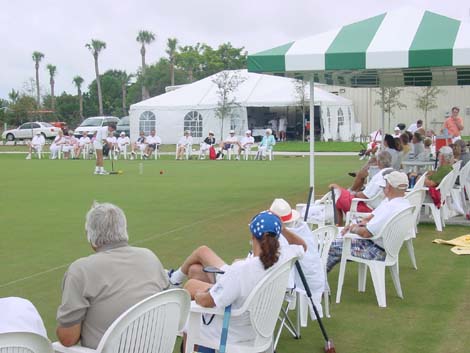
|
They said, "I had no idea it was anything like this!" No one predicted it. This is the kind of visionary enterprise about which one says, "It could happen only in America." We will soon raise the stars and stripes above this Center and salute the spirit that created it. At the same time, the banners of 20 other countries will rise alongside in celebration of the universal brotherhood of sport. Croquet will be played here in many world championships and international test matches. Hundreds and eventually thousands of new players will learn the sport here. These lawns will be filled every day - even in summer - with USCA members and players from every country who will have to see it to believe that this is possible in the small sport of croquet.
This is what a National Croquet Center looks like. Until now, you had no idea it was anything like this.